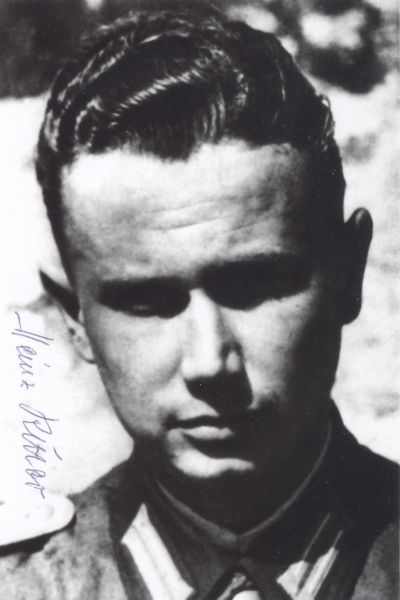Ritter, Heinz-Georg (WH-Gren.Rgt. 44)
- Date of birth:
- May 26th, 1917 (Danzig/West Prussia, Germany)
- Date of death:
- March 10th, 2010 (Neustadt/Schleswick-Holstein, Germany)
- Nationality:
- German
Biography
Heinz-Georg Ritter reached the rank of Major.
Promotions:
January 1st, 1943: Hauptmann (336 h).
Do you have more information about this person? Inform us!
- Period:
- Second World War (1939-1945)
- Rank:
- Hauptmann (Captain)
- Unit:
- Kommandeur, II./Grenadier-Regiment 44, 11. Infanterie-Division, Heer
- Awarded on:
- April 20th, 1945
“On the 17.03.1945 the Russians began attacking the Regiment (which was deployed in a position covering the friendly artillery) with strong infantry and tank forces. The focal point of their attacks was in the sector of Hauptmann Ritter and his II./G.R. 44, located just northwest of Jegles (this was the boundary between the 16. and 18. Armee). The Russians already began assaulting in the morning hours with strong elements of the 29th and 30th Guards Rifle Divisions, supported by 12 tanks.
The Bataillon (which had been reduced to just 2 Schützen-Kompanien with 22 men in each following the Fifth Battle of Courland) was positioned in an unfortified position along the edge of a forest. Only a handful of bunkers were available, and the defenders had sustained high losses because of uninterrupted bombardments by tanks. The defenses had no depth to them, and the Regiment’s heavy weapons were not in position as a result of the relief-in-place that was being conducted.
After the first major losses had occurred, Hauptmann Ritter and his staff immediately went to the frontline and occupied a portion of it themselves. During the entire day he fought the enemy forces from his foxhole with Panzerfaust and Sturmgewehr in hand, and by doing so he inspired his handful of troops to offer their highest level of resistance and bravery.
At 10:00 the enemy breached the Armee boundary near Janaisi and thrust several kilometres northwards into a forest with infantry and 5 tanks before pivoting some of their forces towards the west. At the same time the Russians managed to penetrate the frontline of his right-wing Kompanie with a battalion of their own troops. The immediately sent 4 tanks into this breach and used a further 10 to guard their penetration. The Kompanie commander became a casualty, whilst the Kompanie itself defended the last intact bunker with its final 8 men.
In this critical situation Hauptmann Ritter decided to disregard those enemy forces advancing in his left and rear, and after leaving behind a small strongpoint at the Armee boundary he pulled his Bataillon out of the remainder of the frontline in order to eliminate the breach on the right wing. Leading at the head of his staff (only his combat clerk remained at the radio), he stormed past the 10 T-34s and their strong infantry security element, charged to the right flank and eliminated the breach after a bloody bout of infantry combat. Heavy losses were sustained by both sides, but in the end the enemy battlegroup was destroyed. The Russians lost 40 counted dead, 8 prisoners and 2 tanks destroyed in close combat. Hauptmann Ritter personally damaged a third tank with a Panzerfaust and took 3 prisoners.
The Russians achieved 3 more penetrations on this day in the same strength, but on each occasion he [Ritter] personally led his ever dwindling number of men in a counterthrust and restored the old frontline. Because of this the defensive front of the Regiment remained intact, and all the enemy attacks (prosecuted by several opposing divisions) were fought off.
Hauptmann Ritter’s actions on this day were utterly fearless, and he passed on his will to resist upon every one of his troops. By doing so he laid the groundwork for the covering of the open left flank whilst also eliminating the danger of an imminent breakthrough that would otherwise have ripped apart the Division’s frontline.
Hauptmann Ritter is especially worthy of being awarded the Knight’s Cross of the Iron Cross.”
- Period:
- Second World War (1939-1945)
- Rank:
- Hauptmann (Captain)
- Unit:
- Divisions-Füsilier-Bataillon 11, 11. Infanterie-Division, Heer
- Awarded on:
- October 27th, 1944
- Period:
- Second World War (1939-1945)
- Awarded on:
- August 1st, 1942
- Period:
- Second World War (1939-1945)
- Awarded on:
- January 8th, 1942
- Period:
- Second World War (1939-1945)
- Awarded on:
- September 8th, 1941
- Period:
- Second World War (1939-1945)
- Awarded on:
- June 26th, 1940
Sources
- Photo 1: Willi Schumacher
- - FELLGIEBEL, W.P., Elite of theThird Reich, Helion & Company Limited, Solihull, 2003.
- Vorschlag für die Verleihung des Ritterkreuzes des Eisernen Kreuzes
- BArch RH 7/441









